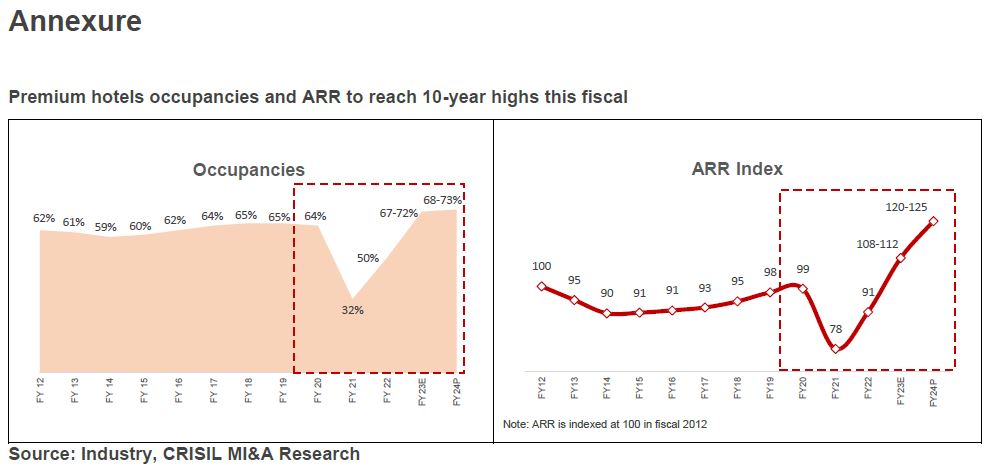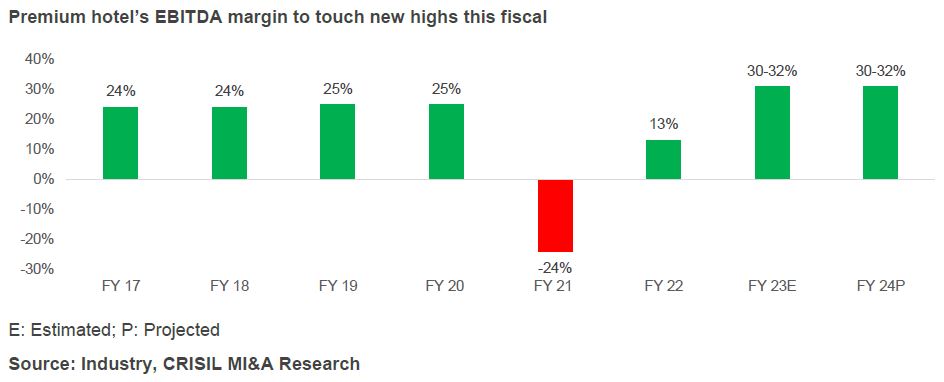The premium hotels sector is expected to log strong growth across operating parameters in the current and next fiscals riding on continued recovery of the economy and waning of the Covid-19 pandemic.
Recovery is visible across categories – leisure, corporate, MICE (meetings, incentives, conferences, and exhibitions), as well as international travel.
Says Pushan Sharma, Director- Research, CRISIL Market Intelligence & Analytics, “The average room rate (ARR) of premium hotels increased 13% on-year in fiscal 2022 and is expected to rise 19-21% in fiscal 2023 to a decadal high of Rs 7,500-10,000. The occupancy level, which was at 50% in fiscal 2022, will also touch a decadal high of 67-72% this fiscal. This is in sharp contrast to fiscal 2021, which saw ARR plunge 20-25% on-year and occupancy halve to 31% following the pandemic onset.”
The growth in ARR and occupancy in fiscal 2023 is largely because of improving domestic demand, including revenge travel, leisure, corporate, and MICE events. In fact, demand for staycations is increasing as a form of revenge travel, with blending of business and leisure (bleisure) also observed.
Foreign tourist arrivals, though, are yet to reach pre-pandemic level. As per Ministry of Tourism data, foreign tourist arrivals in the first nine months of fiscal 2023 were ~54 lakh, which was only ~70% of the fiscal 2020 level.
In fiscal 2024, international passenger arrival is expected to recover to pre-pandemic level as well. Also, various events, including the Indian Premier League and the G20 summit, and continued demand from corporates, leisure travel, MICE events and weddings, will ensure ARRs and occupancies sustain.
Notably, the current recovery is largely K shaped. Whereas premium hotels are expected to report decadal high ARRs and occupancy rates, the budget hotels segment is likely to see ARR trend ~20% higher than pre-pandemic (fiscal 2020) level, but occupancies are at ~90% of the pre-pandemic level. This is similar to what is being seen in other discretionary sectors, such as the automobiles industry, where the premium segment is doing better, i.e. sales of cars priced above Rs 10 lakh are much better than those priced below Rs 10 lakh.
That said, the rate of growth is unlikely to be uniform across premium hotels segments. Leisure destinations are expected to log a higher occupancy level of 70-75% in fiscal 2023 vis-à-vis 65-70% for business destinations, as per CRISIL MI&A Research’s tracking of 12 destinations, of which eight are business and four are leisure. This is despite the ARR at leisure destinations being 1.1x than that of business destinations this fiscal.
Meanwhile, players, which had reduced their employee-to-room ratio to 20-30% between fiscals 2020 and 2022, have carried forward the cost rationalisation even post the revival in demand. This, along with improving ARRs and occupancy levels, is projected to sharply improve the industry’s margins in fiscals 2023 and 2024.
Says Elizabeth Master, Associate Director- Research, CRISIL Market Intelligence & Analytics, “Owing to better operational parameters, revenue of the premium hotel industry is expected to surge ~80% on-year in fiscal 2023, and a further 15-20% in fiscal 2024. Also, employee cost as % of net sales, which was 32% in fiscal 2022, is projected at 21-22% in fiscal 2023. These factors combined will translate into a new high for EBITDA margin at 30-32% for fiscals 2023 and 2024.”
The improving dynamics of players will also lead to an increase in the number of rooms. Supply additions that were deferred due to Covid-19 gathered momentum during fiscals 2022 and 2023. Demand erosion during the peak of the pandemic had put pressure on liquidity of hotel owners, especially single property owners, nudging them towards closure, repurposing or rebranding of their properties. In fiscal 2023, we expect supply to increase 10-12% on-year, with limited supply additions of 3-4% in fiscal 2024.


Be First to Comment